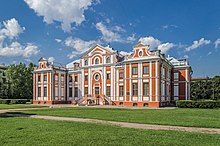Petrine Baroque
Its chief practitioners - Domenico Trezzini, Andreas Schlüter, and Mikhail Zemtsov - drew inspiration from a rather modest Dutch, Danish, and Swedish architecture of the time.
While in rule, Peter attempted to bring about change to the nation of Russia as quickly as possible and tried to incorporate western style and tradition into the everyday lives of his citizens.
The Moscow or Naryshkin Baroque style, named after Peter's maternal side of the family, was prominent in these buildings.
The cabin in St. Petersburg that Peter designed utilized elements from this naval style which Schjinvoet taught him, including flat, painted log walls, wooden tile-like shingles, and windows made from small planes of glass.
In a 1724 letter to the architectural student Ivan Korobov, Peter discusses his preference for the ornamentation of Dutch Baroque.
In this same letter, Peter conveys his disinterest for the architectural styles of the French and Italian due to its lack of adornment and use of stone rather than brick.
Among Peter's papers, a note was found describing how he sent two Russian architecture students to Holland so that they could learn the Dutch Baroque style and come back to build churches and houses for St. Petersburg.
In addition to having Russian students train abroad, Peter also hired Dutch architects to come and work on projects in Russia.
Trezzini and his team designed the layout of the developing St. Petersburg including the streets of the anticipated city center of Vasilyevsky Island.
Trezzini's design of the city did not follow the European ideal at the time because of its lack of compactness and grid organization rather than the traditional ringed layout.
[11] Several engravings of the model homes exist and while they are often accredited to Trezzini himself, his assistant Jean-Baptiste Alexandre Le Blond is responsible for creating them.
For columns, Trezzini preferred squared pilasters as a decorative element and restricted their use to where they were structurally necessary or served a major purpose in the overall design.
















